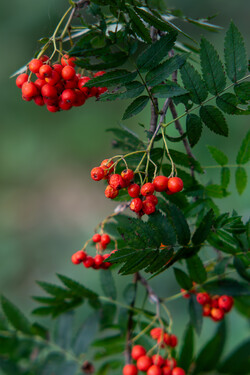We offer a range of incentives and programs to lower financial barriers so that everyone can contribute to reducing our community's environmental impact.
Incentives

Fruit trees attract bears into our neighbourhoods which puts people and wildlife at risk. Bears accessing fruit trees is the one of the main causes of bears needing to be relocated or killed in the Bow Valley.
We are making Canmore safer for people and wildlife by reducing financial barriers to remove fruit trees.
How it Works
- Eligibility: Individuals who own a home or property located within the Town of Canmore.
- Funding: 100% of the pre-tax cost of removal of the fruit tree(s) or bush(es) by an arborist or tree removal service up to $500/property.
- New this year! Condos or commercial properties with five or more trees for removal may be eligible for additional support (up to $1000/property) for 2024 only.
- Program is first-come first-served while funds are available.
How to Apply
Applications are now open!
Thank you for your interest in removing fruit trees from your property to advance wildlife coexistence in our community. To apply for the incentive program:
- Send an email to sustainability@canmore.ca with the subject line: fruit tree incentive program and indicate you are interested in the program.
- Once you receive a reply, contract an arborist or tree removal service to remove the fruit tree(s) and/or bush(es) from your property.
- Once the fruit tree(s) or bush(es) have been removed, email a copy of your paid invoice to sustainability@canmore.ca.
- We will then reimburse you for the cost of removal up to $500/property, and for 2024 only, up to $1000 per property for condos or commercial properties with five or more trees for removal.
Timeframe: Annually, while funds remain available

The 2024 program is now closed. Successful candidates were contacted directly.
Investing in solar energy can be a great way to reduce emissions while reducing energy costs; however, the upfront cost can be a financial barrier. That is why we are proud to offer an annual incentive to help offset the cost of a rooftop solar photovoltaic (PV) system for Canmore residents and businesses.
How the Residential Program Works
- The residential incentive is $1,250, regardless of the size of the solar PV system.
- We are offering 20 incentives of $1,250 towards the installation of a solar photo voltaic rooftop array for Canmore homeowners with a minimum of 3 kW.
- The incentive is for residential homes (single family, duplexes, tri- and four-plexes, individual townhouses, etc.).
- The incentive is not retroactive for existing systems.
- Successful applicants will be selected by lottery and contacted directly with next steps.
How the Commercial Program Works
- The commercial incentive is based on the system size; $750/kW to a maximum of $20,000.
- The incentive applies to both new construction and existing buildings.
- For a multi-family building, the system needs to service the building common areas and/or all units. Individual condo owners installing a system that will provide power only for their unit can apply to the Residential Program.
- The incentive is not retroactive for existing systems.
- Successful applicants will be selected by lottery, with funding secured based on proposed size, and will be contacted directly with next steps.
Other Programs

Over half of Canmore’s greenhouse gas (GHG) emissions are from existing buildings. Homeowners can now apply for the Clean Energy Improvement Program (CEIP) – an innovative financing tool for property owners to reduce GHG emissions by investing in energy efficient and renewable energy upgrades without an upfront cost.
CEIP provides a low interest financing option for loans related to energy efficiency upgrades (solar, insulation, windows, etc.). You then make repayments through your annual property tax bills. CEIP repayment is tied to the property, not the property owner. If the home is sold, the new owner assumes responsibility for repayment, while also enjoying the energy savings and other benefits of the upgrade(s).
The CEIP can be combined with the Residential Solar Incentive if the timelines align. If you are selected to receive a Solar Incentive the funding will be applied to the CEIP financing instead of being paid directly to you.
How the Program Works
- Residents can finance 100% of the cost for energy upgrades, including windows and doors, insulation, high efficiency furnaces and water heaters, air source heat pumps, and solar photovoltaic installations.
- Homeowners need to be full time residents and have five years of property tax history to be eligible.
- The Clean Energy Improvement Program is first come, first served.
- Repayment is through property tax with terms based on the effective useful life of the completed upgrades, to a maximum of 20 years.
- CEIP is stackable with rebates and incentives.
- Grant and loan funding from the Federation of Canadian Municipalities offsets the program administration and the upfront costs for the home energy upgrades from 2022-2026.
- CEIP contributes to local economic growth by providing opportunities for contractors. To work on CEIP projects, electricians, plumbers, HVAC technicians, energy auditors, window, insulation, and solar installers must become a CEIP Qualified Contractorwith Alberta Municipalities.
How to Apply
The application process for CEIP is administered by Alberta Municipalities. Submit your application on their website.
